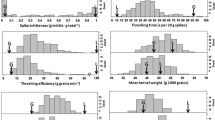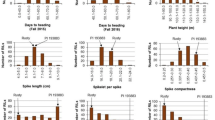Abstract
Main conclusion
Transformation from q to Q during wheat domestication functioned outside the boundary of threshability to increase yield, grains m−2, grain weight and roundness, but to reduce grains per spike/spikelet.
Mutation of the Q gene, well-known affecting wheat spike structure, represents a key domestication step in the formation of today’s free-threshing, economically important wheats. In a previous study, multiple yield components and spike characteristics were associated with the Q gene interval in the bread wheat ‘Forno’ × European spelt ‘Oberkulmer’ recombinant inbred line population. Here, we reported that this interval was also associated with grain yield, grains m−2, grain morphology, and spike dry weight at anthesis. To clarify the roles of Q in agronomic trait performance, a functional marker for the Q gene was developed. Analysis of allelic effects showed that the bread wheat Q allele conferred free-threshing habit, soft glumes, and short and compact spikes compared with q. In addition, the Q allele contributed to higher grain yield, more grains m−2, and higher thousand grain weight, whereas q contributed to more grains per spike/spikelet likely resulting from increased preanthesis spike growth. For grain morphology, the Q allele was associated with reduced ratio of grain length to height, indicating a rounder grain. These results are supported by analysis of four Q mutant lines in the Chinese Spring background. Therefore, the transition from q to Q during wheat domestication had profound effects on grain yield and grain shape evolution as well, being a consequence of pleiotropy.



Similar content being viewed by others
Abbreviations
- AP2:
-
APETALA2
- CS:
-
Chinese Spring
- QTL:
-
Quantitative trait locus
- RIL:
-
Recombinant inbred line
- TGW:
-
Thousand grain weight
References
Avni R, Nave M, Barad O, Baruch K, Twardziok SO, Gundlach H, Hale I, Mascher M, Spannagl M, Wiebe K, Jordan KW, Golan G, Deek J, Ben-Zvi B, Ben-Zvi G, Himmelbach A, MacLachlan RP, Sharpe AG, Fritz A, Ben-David R, Budak H, Fahima T, Korol A, Faris JD, Hernandez A, Mikel MA, Levy AA, Steffenson B, Maccaferri M, Tuberosa R, Cattivelli L, Faccioli P, Ceriotti A, Kashkush K, Pourkheirandish M, Komatsuda T, Eilam T, Sela H, Sharon A, Ohad N, Chamovitz DA, Mayer KFX, Stein N, Ronen G, Peleg Z, Pozniak CJ, Akhunov ED, Distelfeld A (2017) Wild emmer genome architecture and diversity elucidate wheat evolution and domestication. Science 357:93–97
Bowman JL, Smyth DR, Meyerowitz EM (1989) Genes directing flower development in Arabidopsis. Plant Cell 1:37–52
Bradbury PJ, Zhang Z, Kroon DE, Casstevens TM, Ramdoss Y, Buckler ES (2007) TASSEL: software for association mapping of complex traits in diverse samples. Bioinformatics 23:2633–2635
Braun HJ, Atlin G, Payne T (2010) Multi-location testing as a tool to identify plant response to global climate change. In: Reynolds MP (ed) Climate change and crop production. CABI, Wallingford, pp 115–138
Chuck G, Meeley R, Hake S (2008) Floral meristem initiation and meristem cell fate are regulated by the maize AP2 genes ids1 and sid1. Development 135:3013–3019
Debernardi JM, Lin H, Faris JD, Dubcovsky J (2017) microRNA172 plays a critical role in wheat spike morphology and grain threshability. Development 144:1966–1975
Faris JD (2014) Wheat domestication: Key to agricultural revolutions past and future. In: Tuberosa R, Graner A, Frison E (eds) Genomics of plant genetic resources. Springer, Houten, pp 439–464
Faris JD, Fellers JP, Brooks SA, Gill BS (2003) A bacterial artificial chromosome contig spanning the major domestication locus Q in wheat and identification of a candidate gene. Genetics 164:311–321
Fischer RA (2011) Wheat physiology: a review of recent developments. Crop Pasture Sci 62:95–114
Foulkes MJ, Slafer GA, Davies WJ, Berry PM, Sylvester-Bradley R, Martre P, Calderini DF, Griffiths S, Reynolds MP (2011) Raising yield potential of wheat. III. Optimizing partitioning to grain while maintaining lodging resistance. J Exp Bot 62:469–486
Gegas VC, Nazari A, Griffiths S, Simmonds J, Fish L, Orford S, Sayers L, Doonan JH, Snape JW (2010) A genetic framework for grain size and shape variation in wheat. Plant Cell 22:1046–1056
Gill BS, Li W, Sood S, Kuraparthy V, Friebe BR, Simons KJ, Zhang Z, Faris JD (2007) Genetics and genomics of wheat domestication-driven evolution. Isr J Plant Sci 55:223–229
González FG, Miralles DJ, Slafer GA (2011) Wheat floret survival as related to pre-anthesis spike growth. J Exp Bot 62:4889–4901
Greenwood JR, Finnegan EJ, Watanabe N, Trevaskis B, Swain SM (2017) New alleles of the wheat domestication gene Q reveal multiple roles in growth and reproductive development. Development 144:1959–1965
Irish VF, Sussex IM (1990) Function of the apetala-1 gene during Arabidopsis floral development. Plant Cell 2:741–753
Jantasuriyarat C, Vales M, Watson C, Riera-Lizarazu O (2004) Identification and mapping of genetic loci affecting the free-threshing habit and spike compactness in wheat (Triticum aestivum L.). Theor Appl Genet 108:261–273
Jofuku KD, den Boer BGW, Van Montagu M, Okamuro JK (1994) Control of Arabidopsis flower and seed development by the homeotic gene APETALA2. Plant Cell 6:1211–1225
Jofuku KD, Omidyar PK, Gee Z, Okamuro JK (2005) Control of seed mass and seed yield by the floral homeotic gene APETALA2. Proc Natl Acad Sci USA 102:3117–3122
Kato K, Miura H, Sawada S (2000) Mapping QTLs controlling grain yield and its components on chromosome 5A of wheat. Theor Appl Genet 101:1114–1121
Kato K, Sonokawa R, Miura H, Sawada S (2003) Dwarfing effect associated with the threshability gene Q on wheat chromosome 5A. Plant Breed 122:489–492
Kerber ER, Rowland GG (1974) Origin of the free threshing character in hexaploid wheat. Can J Genet Cytol 16:145–154
Kovach MJ, Sweeney M, Mccouch SR (2007) New insights into the history of rice domestication. Trends Genet 23:578–587
Lee D, Lee J, Moon S, Park SY, An G (2006) The rice heterochronic gene SUPERNUMERARY BRACT regulates the transition from spikelet meristem to floral meristem. Plant J 49:64–78
Lev-Yadun S, Gopher A, Abbo S (2000) The cradle of agriculture. Science 288:1602–1603
Li B, Li Q, Mao X, Li A, Wang J, Chang X, Hao C, Zhang X, Jing R (2016) Two novel AP2/EREBP transcription factor genes TaPARG have pleiotropic functions on plant architecture and yield-related traits in common wheat. Front Plant Sci 7:1191
Liu P, Liu J, Dong H, Sun J (2017) Functional regulation of Q by microRNA172 and transcriptional co-repressor TOPLESS in controlling bread wheat spike density. Plant Biotechnol J. https://doi.org/10.1111/pbi.12790
Ma ZQ, Sorrells ME (1995) Genetic analysis of fertility restoration in wheat using restriction fragment length polymorphisms. Crop Sci 35:1137–1143
Maes T, Van de Steene N, Zethof J, Karimi M, D’Hauw M, Mares G, Van Montagu M, Gerats T (2001) Petunia Ap2-like genes and their role in flower and seed development. Plant Cell 13:229–244
Messmer MM, Keller M, Zanetti S, Keller B (1999) Genetic linkage map of a wheat × spelt cross. Theor Appl Genet 98:1163–1170
Muramatsu M (1963) Dosage effect of the spelta gene q of hexaploid wheat. Genetics 48:469–482
Neff MM, Turk E, Kalishman M (2002) Web-based primer design for single nucleotide polymorphism analysis. Trends Genet 18:613–615
Ohto M, Fischer RL, Goldberg RB, Nakamura K, Harada JJ (2005) Control of seed mass by APETALA2. Proc Natl Acad Sci USA 102:3123–3128
Peleg Z, Fahima T, Korol AB, Abbo S, Saranga Y (2011) Genetic analysis of wheat domestication and evolution under domestication. J Exp Bot 62:5051–5061
Peng J, Ronin Y, Fahima T, Röder MS, Li Y, Nevo E, Korol A (2003) Domestication quantitative trait loci in Triticum dicoccoides, the progenitor of wheat. Proc Natl Acad Sci USA 100:2489–2494
Salamini F, Özkan H, Brandolini A, Schäfer-Pregl R, Martin W (2002) Genetics and geography of wild cereal domestication in the Near East. Nat Rev Genet 3:429–441
Sharma HC, Waines JG (1980) Inheritance of tough rachis in crosses of Triticum monococcum and T. boeoticum. J Hered 71:214–216
Shomura A, Izawa T, Ebana K, Ebitani T, Kanegae H, Konishi S, Yano M (2008) Deletion in a gene associated with grain size increased yields during rice domestication. Nat Genet 40:1023–1028
Simonetti MC, Bellomo MP, Laghetti G, Perrino P, Simeone R, Blanco A (1999) Quantitative trait loci influencing free-threshing habit in tetraploid wheats. Genet Resour Crop Evol 46:267–271
Simons KJ, Fellers JP, Trick HN, Zhang Z, Tai YS, Gill BS, Faris JD (2006) Molecular characterization of the major wheat domestication gene Q. Genetics 172:547–555
Song XJ, Huang W, Shi M, Zhu MZ, Lin HX (2007) A QTL for rice grain width and weight encodes a previously unknown RING-type E3 ubiquitin ligase. Nat Genet 39:623–630
Taenzler B, Esposti RF, Vaccino P, Brandolini A, Effgen S, Heun M, SchÄFer-Pregl R, Borghi B, Salamini F (2002) Molecular linkage map of Einkorn wheat: mapping of storage-protein and soft-glume genes and bread-making quality QTLs. Genet Res 80:131–143
Van Ooijen JW (2006) JoinMap® 4, software for the calculation of genetic linkage maps in experimental populations. Kyazma BV, Wageningen
Van Ooijen JW (2009) MapQTL® 6, software for the mapping of quantitative traits loci in experimental populations of diploid species. Kyazma BV, Wageningen
Watanabe N, Sugiyama K, Yamagishi Y, Sakata Y (2002) Comparative telosomic mapping of homoeologous genes for brittle rachis in tetraploid and hexaploid wheats. Hereditas 137:180–185
Xie Q, Mayes S, Sparkes DL (2015) Spelt as a genetic resource for yield component improvement in bread wheat. Crop Sci 55:2753–2765
Yant L, Mathieu J, Dinh TT, Ott F, Lanz C, Wollmann H, Chen X, Schmid M (2010) Orchestration of the floral transition and floral development in Arabidopsis by the bifunctional transcription factor APETALA2. Plant Cell 22:2156–2170
Zhang Z, Belcram H, Gornicki P, Charles M, Just J, Huneau C, Magdelenat G, Couloux A, Samain S, Gill BS, Rasmussen JB, Barbe V, Faris JD, Chalhoub B (2011) Duplication and partitioning in evolution and function of homoeologous Q loci governing domestication characters in polyploid wheat. Proc Natl Acad Sci USA 108:18737–18742
Zhou Y, Lu D, Li C, Luo J, Zhu B, Zhu J, Shangguan Y, Wang Z, Sang T, Zhou B, Han B (2012) Genetic control of seed shattering in rice by the APETALA2 transcription factor SHATTERING ABORTION1. Plant Cell 24:1034–1048
Acknowledgements
We thank Beat Keller (University of Zurich) and Justin Faris (USDA-ARS) for providing the Forno × Oberkulmer mapping population and CS Q mutants, respectively. We also thank John Alcock, Matthew Tovey and Fiona Wilkinson (University of Nottingham) for their help with field and laboratory work. This study was partially supported by Natural Science Foundation of China (No.: 31430064), Natural Science Foundation of Jiangsu Province, China (No.: BK20160714), Research Excellence Foundation for the Overseas Chinese Scholars, Ministry of Human Resources and Social Security, China (No.: 8020012), China Scholarship Council‒University of Nottingham Research Excellence Scholarship, Jiangsu Collaborative Innovation Initiative for Modern Crop Production, and ‘111’ Project (No.: B08025).
Author information
Authors and Affiliations
Corresponding author
Ethics declarations
Conflict of interest
The authors declare that they have no conflicts of interest.
Rights and permissions
About this article
Cite this article
Xie, Q., Li, N., Yang, Y. et al. Pleiotropic effects of the wheat domestication gene Q on yield and grain morphology. Planta 247, 1089–1098 (2018). https://doi.org/10.1007/s00425-018-2847-4
Received:
Accepted:
Published:
Issue Date:
DOI: https://doi.org/10.1007/s00425-018-2847-4




